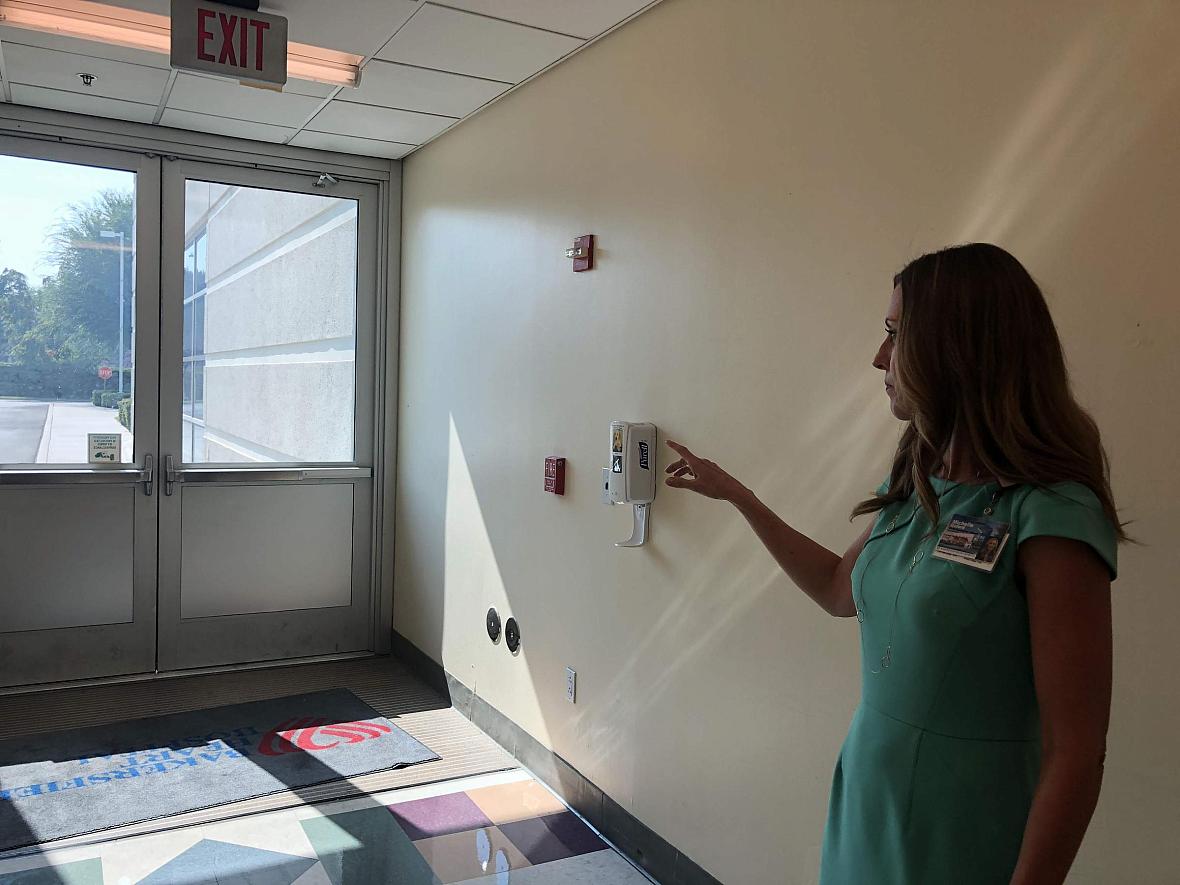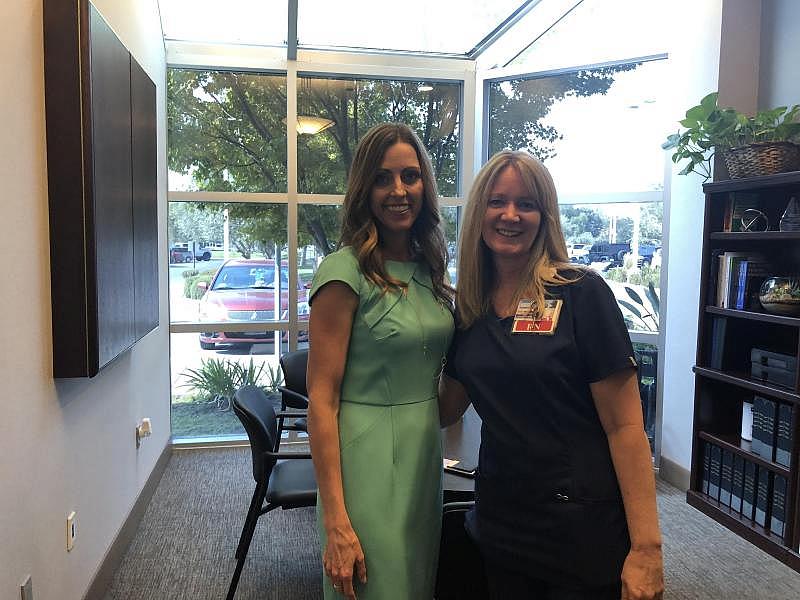Hospitals Comply With Violence Prevention Rules, But Rules Only Go So Far
This story was produced as a project for the USC Annenberg Center for Health Journalism’s 2018 California Fellowship.
Other stories in this series include:
For Health Care Employees, Workplace Violence Is More Common Than You Might Think
How One Emergency Department Director Works To Reduce Risks Of Violence
To Change A Culture, Health Care Educators Say Best Practices Start With Students

Michelle Oxford, CEO at Bakersfield Heart Hospital, shows where a gunman shot into the facility back in December of last year. (Photo by Laura Tsutsui/Valley Public Radio)
Over the last few weeks, we’ve been looking at how those who work in health care are at increased risk of workplace violence. In the next installment of our series, Part of the Job, we see that although hospitals in the Valley have preventive measures in place, some are finding that it’s not until an incident happens that a facility knows what more to improve.
Community Regional Medical Center is in Downtown Fresno. The hospital sees patients from it’s own neighborhood, as well as those from all over the Central Valley. Nicole Ozburn is the hospital’s director of employee health and safety. She says that while incidents are common, not all of them are severe.
“I get a ping just about every day,” Ozburn says. “But, sometimes it's just verbal. So it's not necessarily huge issues, but we want everybody to report everything because one of the things that we’re fighting a stigma of is that violence and health care is acceptable.”
She says this attitude starts with training. Everyone at CRMC receives online training about violence, and what to do if something happens. But it also depends on where people work within the facility. Ozburn says that those who face the public, like in the Emergency Department, receive more training than others.
“So our staff, they’re trained to look for behavioral cues as warning signs, somebody that's becoming agitated or violent,” says Ozburn. “So if we can catch somebody in a lower-level situation, where they're just confused or frustrated, it's easier to de-escalate them.”
Ozburn says employees watch for dangerous behaviors even when someone sets foot in the hospital. Anyone entering the emergency room first meets a security guard and walks through a metal detector.
“If something triggers the metal detector they know they have to get further eyes on that person,” says Ozburn.
Ozburn notes the hospital is constantly making updates and investigating incidents to understand how to prevent violent encounters. At the same time, though, she says that being aware isn’t limited to working at a hospital.
“In any of our facilities or anywhere you go in your personal life, never let your guard down, because if you're in a public place, you're at risk.”
With increased awareness of shootings in recent years, it’s not surprising, then that hospitals deal with guns too.
Michelle Oxford is the CEO at Bakersfield Heart Hospital. In early December of last year, a man shot into the facility and entered with a rifle.
“It was on Friday afternoon, around 4:51 p.m. a staff member came up and said there was something in the parking lot, back employee entrance with a weapon,” Oxford recalls.
“For a hospital a person with a weapon is a code silver, so we called ‘Code Silver’ overhead,” says Oxford. “Our staff has had so much training that they know that means to barricade themselves into whatever areas they are, make sure to keep patients and families safe.”
The man entered the building through an employee entrance. Oxford actually met him in the hallway when she was trying to check on her staff, and she says she immediately returned to her office.
“When Laura and I ran into my office we both reached for the door to lock it and there is not a lock because you unlock your door with your key on the outside,” says Oxford. “So we both sat down and tried to block the door with our bodies. I don't think that's something you would ever think about without actually experiencing it.”
Michelle Oxford is the CEO, and Laura Cunanan, RN, is the Vice President of Clinical at Bakersfield Heart Hospital. When a man with a rifle entered their facility, they realized more ways to increase hospital safety.
The hospital has since added cameras, so-called columbine locks, and replaced the employee entrance that the gunman shot through. But again, these were changes made after the active-shooter incident. Before that, Bakersfield Heart was already working to comply with the new state regulation to decrease workplace violence in health care.
Gail Blanchard-Saiger is with the California Hospital Association. She says that while hospitals take safety seriously, the new California state rule is an unfunded mandate. Facilities have had limited resources to become compliant.
“And that's why I think there are a lot of resources out there because people need to pick what works best for them. You know, Downtown Los Angeles is different than Madera,” says Blanchard-Saiger.
Additionally, she says the new state reporting system implemented by the rule lacks nuance.
“If you can't get to the genesis of what the situation was, then how can you look at preventing it? Because I think in reality, you're never going to get to zero,” Blanchard-Saiger says.
The rule requires that incidents are reported within twenty-four hours, but Blanchard-Saiger says it’s hard for facilities to get to the root of why something happened in that time.
She adds that she’s not sure if the regulation will decrease incidents because data on violence in health care is limited to begin with. But perhaps that’s exactly what required reporting and a change in culture can contribute to.
And, as Blanchard-Saiger says, hospitals will never eliminate incidents entirely. Violence, in any job, may never be completely avoidable. But for those in health care, the hope is that it is no longer simply part of the job.
[This story was originally published by Valley Public Radio.]

